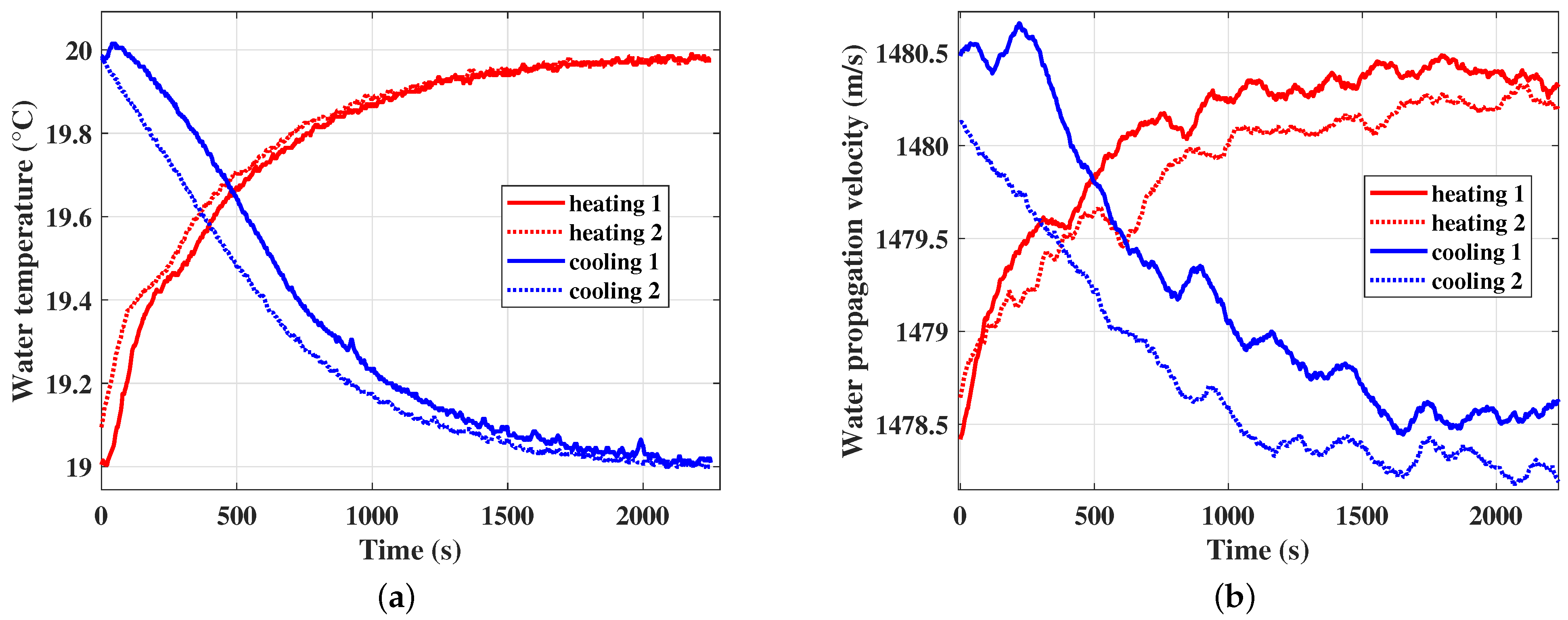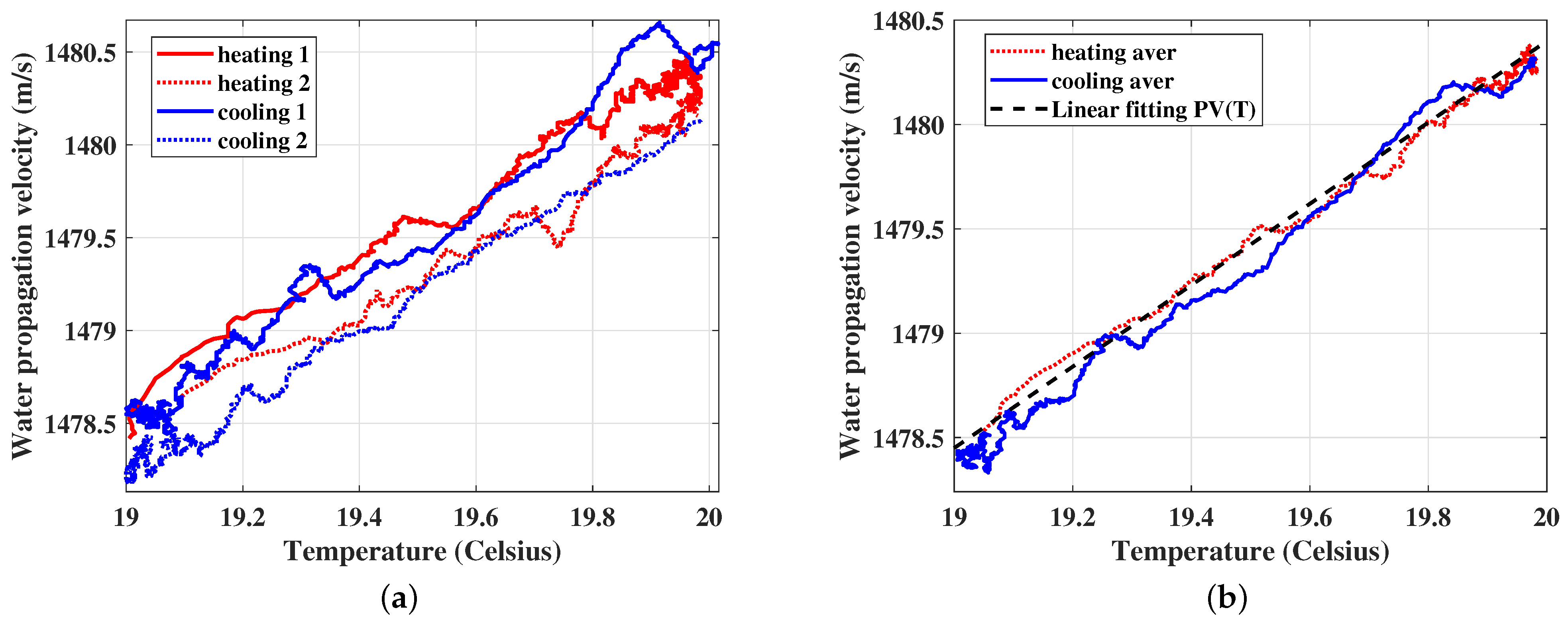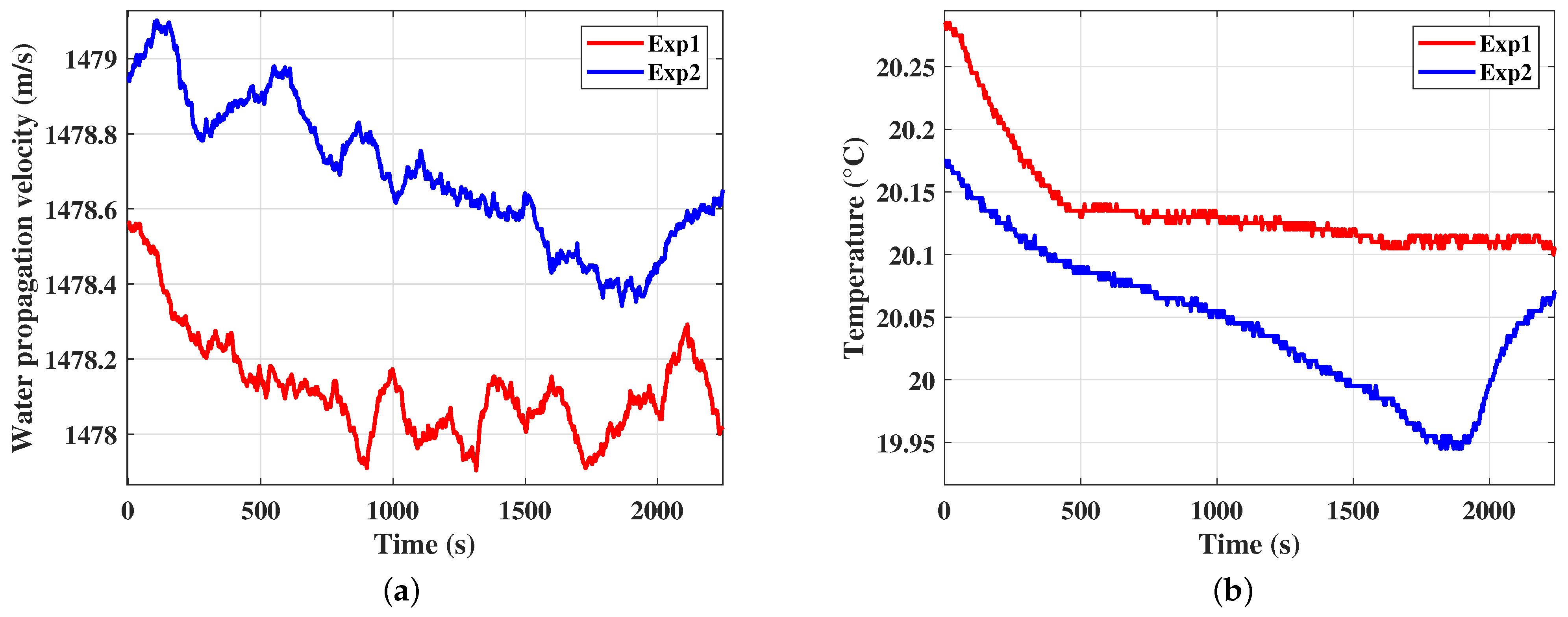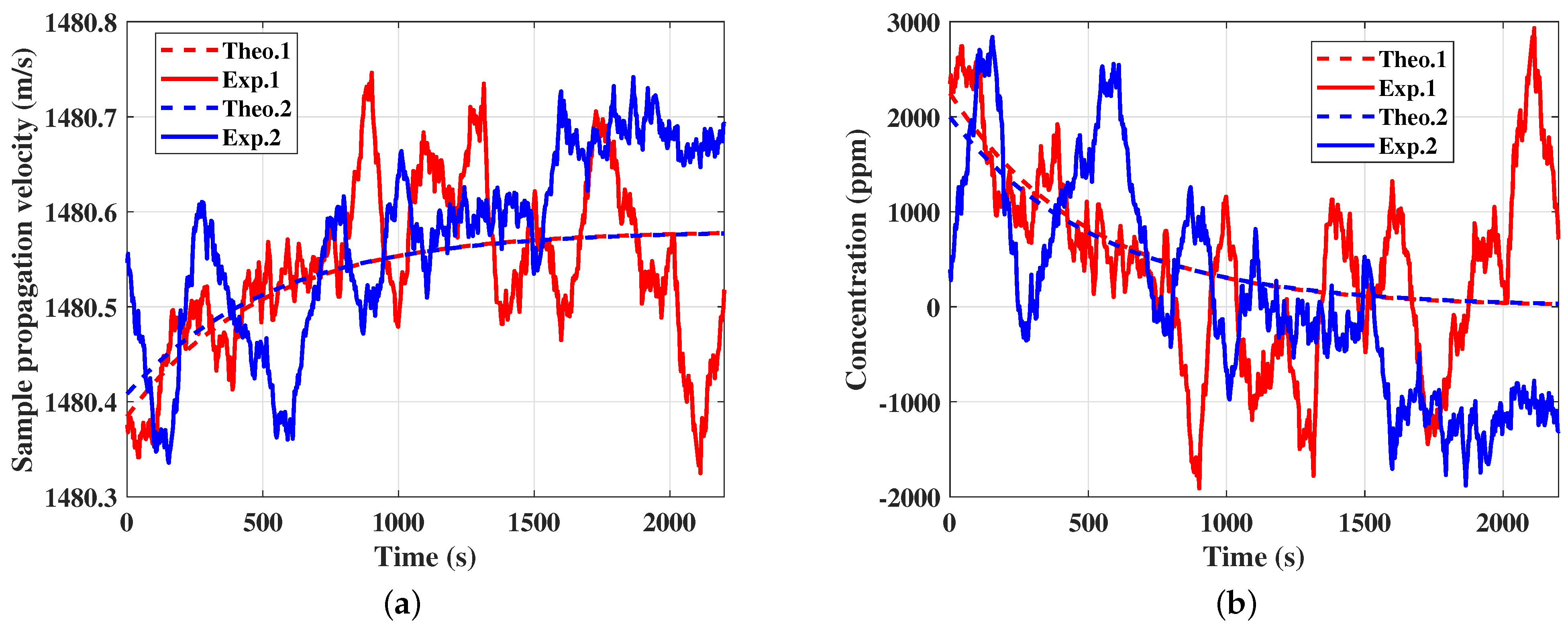Concentration Monitoring of Highly-Diluted Crude Oil-In-Water Emulsions by Ultrasonic Backscattering Sensors
Abstract
1. Introduction
2. Theoretical Background
2.1. Propagation Velocity
2.2. Dilution Process Model
3. Materials and Methods
3.1. Ultrasonic Backscattering Probes
3.2. Experimental Setup
3.3. Experimental Procedure
3.4. Signal Processing
4. Results and Discussion
5. Conclusions
Author Contributions
Funding
Data Availability Statement
Conflicts of Interest
References
- Stewart, M.; Arnold, K. Emulsions and Oil Treating Equipment; Elsevier: Amsterdam, The Netherlands, 2009. [Google Scholar] [CrossRef]
- Jadoon, S.; Malik, A.; Amin, A.A. Separation of Sediment Contents and Water from Crude Oil of Khurmala and Guwayer Oil Fields in Kurdistan Region by using Centrifuge Method. Int. J. Adv. Eng. Res. Sci. 2017, 4, 2919–2922. [Google Scholar] [CrossRef]
- Ivanova, P.G.; Aneva, Z.V. Assessment and assurance of quality in water measurement by coulometric Karl Fischer titration of petroleum products. Accredit. Qual. Assur. 2006, 10, 543–549. [Google Scholar] [CrossRef]
- Shah, A.; Fishwick, R.; Wood, J.; Leeke, G.; Rigby, S.; Greaves, M. A review of novel techniques for heavy oil and bitumen extraction and upgrading. Energy Environ. Sci. 2010, 3, 700–714. [Google Scholar] [CrossRef]
- Runrun, H.; Runyang, M.; Chenghui, W.; Jing, H. Ultrasonic shear-wave reflectometry applied to monitor the dynamic viscosity of reheated edible oil. J. Food Process Eng. 2020, 43, e13402. [Google Scholar] [CrossRef]
- Franco, E.E.; Adamowski, J.C.; Higuti, R.T.; Buiochi, F. Viscosity measurement of Newtonian liquids using the complex reflection coefficient. IEEE Trans. Ultrason. Ferroelectr. Freq. Control 2008, 55, 2247–2253. [Google Scholar] [CrossRef]
- Kazys, R.; Voleisis, A.; Sliteris, R. Investigation of the Acoustic Properties of Viscosity Standards. Arch. Acoust. 2016, 41, 55–58. [Google Scholar] [CrossRef]
- Alig, I.; Lellinger, D.; Sulimma, J.; Tadjbakhsch, S. Ultrasonic shear wave reflection method for measurements of the viscoelastic properties of polymer films. Rev. Sci. Instrum. 1997, 68, 1536–1542. [Google Scholar] [CrossRef]
- Wang, X.; Subramaniam, K.V.; Lin, F. Ultrasonic measurement of viscoelastic shear modulus development in hydrating cement paste. Ultrasonics 2010, 50, 726–738. [Google Scholar] [CrossRef] [PubMed]
- Higuti, R.; Bacaneli, E.; Furukawa, C.; Adamowski, J. Ultrasonic characterization of emulsions: Milk and water in oil. In Proceedings of the 1999 IEEE Ultrasonics Symposium. Proceedings. International Symposium (Cat. No.99CH37027), Tahoe, NV, USA, 17–20 October 1999; Volume 1, pp. 779–782. [Google Scholar] [CrossRef]
- McClements, D.J. Ultrasonic characterizations of emulsions and suspensions. Adv. Colloid Interface Sci. 1997, 37, 33–72. [Google Scholar] [CrossRef]
- Stolojanu, V.; Prakash, A. Cgaracterization of slurry systems by ultrasonic techniques. Chem. Eng. J. 2001, 84, 215–222. [Google Scholar] [CrossRef]
- Franco, E.E.; Henao Santa, S.; Cabrera, J.J.; Laín, S. Air Flow Monitoring in a Bubble Column Using Ultrasonic Spectrometry. Fluids 2024, 9, 163. [Google Scholar] [CrossRef]
- Alshaafi, E.; Prakash, A.; Mercer, S. Ultrasonic based methods to characterize stability of water-in-crude oil emulsions. Colloids Surfaces A Physicochem. Eng. Asp. 2021, 614, 125900. [Google Scholar] [CrossRef]
- Durán, A.L.; Franco, E.E.; Reyna, C.A.B.; Pérez, N.; Tsuzuki, M.S.G.; Buiochi, F. Water Content Monitoring in Water-in-Crude-Oil Emulsions Using an Ultrasonic Multiple-Backscattering Sensor. Sensors 2021, 21, 5088. [Google Scholar] [CrossRef] [PubMed]
- Perez, N.; Blasina, F.; Buiochi, F.; Duran, A.; Adamowski, J. Evaluation of a multiple scattering sensor for water-in-oil emulsion monitoring. Proc. Meet. Acoust. 2020, 38, 055007. [Google Scholar] [CrossRef]
- Chillara, V.K.; Sturtevant, B.T.; Pantea, C.; Sinha, D.N. Ultrasonic sensing for noninvasive characterization of oil-water-gas flow in a pipe. AIP Conf. Proc. 2017, 1806, 090014. [Google Scholar] [CrossRef]
- Franco, E.E.; Adamowski, J.C.; Buiochi, F. Ultrasonic sensor for the presence of oily contaminants in water. Dyna 2012, 79, 4–9. [Google Scholar]
- Meng, G.; Jaworski, A.J.; White, N.M. Composition measurements of crude oil and process water emulsions using thick-film ultrasonic transducers. Chem. Eng. Process. Process Intensif. 2006, 45, 383–391. [Google Scholar] [CrossRef]
- Lu, Z.Q.; Yang, X.; Zhao, K.; Wei†, J.X.; Jin, W.J.; Jiang, C.; Zhao, L.J. Non-contact Measurement of the Water Content in Crude Oil with All-Optical Detection. Energy Fuels 2015, 29, 2919–2922. [Google Scholar] [CrossRef]
- Moradi, M.; Alvarado, V.; Huzurbazar, S. Effect of salinity on water-in-crude oil emulsion: Evaluation through drop-size distribution proxy. Energy Fuels 2011, 25, 260–268. [Google Scholar] [CrossRef]
- Maia Filho, D.C.; Ramalho, J.B.; Spinelli, L.S.; Lucas, E.F. Aging of water-in-crude oil emulsions: Effect on water content, droplet size distribution, dynamic viscosity and stability. Colloids Surfaces A Physicochem. Eng. Asp. 2012, 396, 208–212. [Google Scholar] [CrossRef]
- Reyna, C.A.; Franco, E.E.; Tsuzuki, M.S.; Buiochi, F. Water content monitoring in water-in-oil emulsions using a delay line cell. Ultrasonics 2023, 134, 107081. [Google Scholar] [CrossRef] [PubMed]
- Reyna, C.A.B.; Franco, E.E.; Durán, A.L.; Pereira, L.O.V.; Tsuzuki, M.S.G.; Buiochi, F. Water Content Monitoring in Water-in-Oil Emulsions Using a Piezoceramic Sensor. Machines 2021, 9, 335. [Google Scholar] [CrossRef]
- Reis, J.C.R.; Santos, Â.F.; Lampreia, I.M. Chemical thermodynamics of ultrasound speed in solutions and liquid mixtures. ChemPhysChem 2010, 11, 508–516. [Google Scholar] [CrossRef] [PubMed]
- Ernst, S.; Glinski, J. Comment: Ultrasonic velocities for deuterium oxide–water mixtures at 298.15 K. Can. J. Chem. 1979, 57, 2333–2334. [Google Scholar] [CrossRef]
- Silva, C.A.; Saraiva, S.V.; Bonetti, D.; Higuti, R.T.; Cunha, R.L.; Pereira, L.O.; Silva, F.V.; Fileti, A.M. Application of acoustic models for polydisperse emulsion characterization using ultrasonic spectroscopy in the long wavelength regime. Colloids Surfaces A Physicochem. Eng. Asp. 2020, 602, 125062. [Google Scholar] [CrossRef]
- Adamowski, J.C.; Buiochi, F.; Sigelmann, R.A. Ultrasonic measurement of density of liquids flowing in tubes. IEEE Trans. Ultrason. Ferroelectr. Freq. Control 1998, 45, 48–56. [Google Scholar] [CrossRef] [PubMed]
- Reyna, C.A.B.; Lopes, J.H.; Franco, E.E.; Tsuzuki, M.S.G.; Buiochi, F. Validation of a three-dimensional model for improving the design of multiple-backscattering ultrasonic sensors. J. Acoust. Soc. Am. 2025, 157, 17–28. [Google Scholar] [CrossRef]
- Grosso, V.A.D.; Mader, C.W. Speed of Sound in Pure Water. J. Acoust. Soc. Am. 1972, 52, 1442–1446. [Google Scholar] [CrossRef]







Disclaimer/Publisher’s Note: The statements, opinions and data contained in all publications are solely those of the individual author(s) and contributor(s) and not of MDPI and/or the editor(s). MDPI and/or the editor(s) disclaim responsibility for any injury to people or property resulting from any ideas, methods, instructions or products referred to in the content. |
© 2025 by the authors. Licensee MDPI, Basel, Switzerland. This article is an open access article distributed under the terms and conditions of the Creative Commons Attribution (CC BY) license (https://creativecommons.org/licenses/by/4.0/).
Share and Cite
Reyna, C.A.B.; Franco, E.E.; Laín, S.; de Oliveira, T.F.; Tsuzuki, M.S.G.; Buiochi, F. Concentration Monitoring of Highly-Diluted Crude Oil-In-Water Emulsions by Ultrasonic Backscattering Sensors. Fluids 2025, 10, 108. https://doi.org/10.3390/fluids10050108
Reyna CAB, Franco EE, Laín S, de Oliveira TF, Tsuzuki MSG, Buiochi F. Concentration Monitoring of Highly-Diluted Crude Oil-In-Water Emulsions by Ultrasonic Backscattering Sensors. Fluids. 2025; 10(5):108. https://doi.org/10.3390/fluids10050108
Chicago/Turabian StyleReyna, Carlos A. B., Ediguer E. Franco, Santiago Laín, Timoteo F. de Oliveira, Marcos S. G. Tsuzuki, and Flávio Buiochi. 2025. "Concentration Monitoring of Highly-Diluted Crude Oil-In-Water Emulsions by Ultrasonic Backscattering Sensors" Fluids 10, no. 5: 108. https://doi.org/10.3390/fluids10050108
APA StyleReyna, C. A. B., Franco, E. E., Laín, S., de Oliveira, T. F., Tsuzuki, M. S. G., & Buiochi, F. (2025). Concentration Monitoring of Highly-Diluted Crude Oil-In-Water Emulsions by Ultrasonic Backscattering Sensors. Fluids, 10(5), 108. https://doi.org/10.3390/fluids10050108








